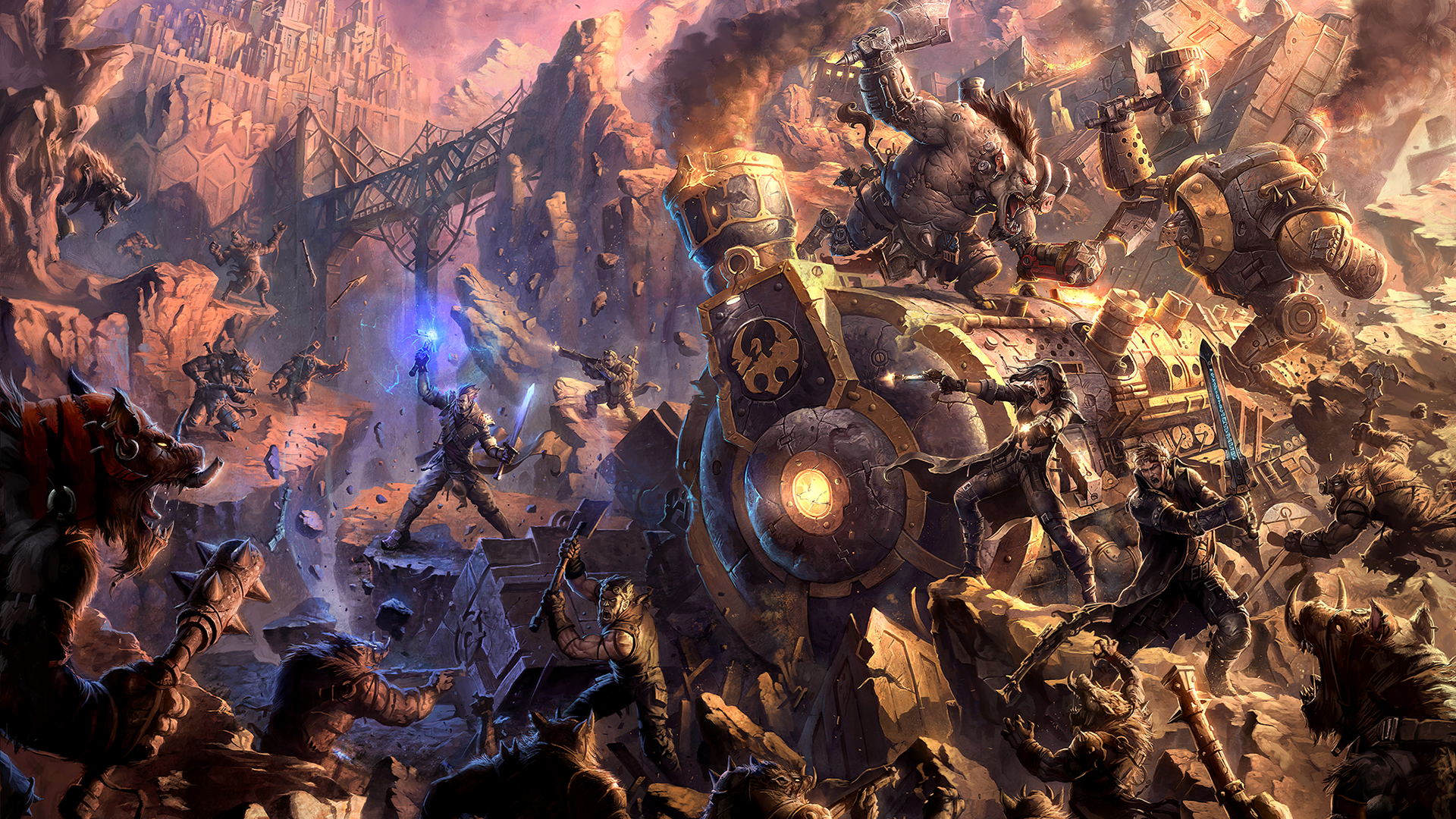
The Claiming
Extinction
Long ago, Zevanna Agha, the Old Witch of Khador—a powerful and mysterious entity who had made the northern lands her home since the time of prehistory—had foreseen the coming threat of the infernals and the cost of the Twins’ bargain with them. In response, she concocted a scheme to unleash the grymkin, creatures created by the Defiers in their nightmare prison in Urcaen, in a time that came to be known as the Wicked Harvest. Her reasoning was simple: by cutting down those whose own wickedness reflected the twisted souls of the grymkin themselves, the Defiers’ scythe would be certain to cull many of the carefully placed infernal agents— whether rich or poor, noble or commoner—who had been deployed in secret throughout the world in order to set their masters’ plans into action.
Zevanna Agha’s gambit worked, albeit at great cost, and
the infernals of the Nonokrion Order were forced to tip
their hand before they were ready. A terrible bill had come
due, and the infernals themselves came to collect it. Western
Immoren had been rocked by innumerable conflicts since the
first humans emerged from Menoth’s shadow, but not since
the days of the Orgoth had it seen a reckoning such as the one
called the Claiming.
The price of the Gift of Magic that Thamar had brought to
humanity was fully two-thirds of all the souls in Caen, and
in 612 AR, the infernals arrived to collect what they were
due. Across the Iron Kingdoms, highly placed individuals of
seemingly spotless renown revealed themselves as having
been secretly in league with these malignant entities, and
they opened gateways through which horrors beyond
comprehension poured into Caen.
Born in the abyss outside both Caen and Urcaen, the
infernals were enemies unlike any the world had ever
faced, although they had been at its edges since time began.
Reliant on souls to survive, their armies swept across the
continent, and wherever they appeared, countless numbers
fell before them.
All seemed lost, and yet this was not the first time that
an apparent dusk had settled upon the people of the Iron
Kingdoms. Just as it appeared inevitable that the infernals
would claim their terrible price, all the nations in the land
united in an unprecedented show of force to drive them
off. Khador and Cygnar, enemies for ages, declared a truce,
and the armies of these two kingdoms marched side by side
against the infernal threat. Undead soldiers of the Nightmare
Empire fought shoulder to shoulder alongside holy warriors
from the Protectorate of Menoth and clockwork priests of
Cyriss, while the skorne and the Iosans forged an unlikely
partnership that ultimately ended in betrayal. Throughout
western Immoren, bitter enemies set aside their differences
to combat a shared foe, and even the gods themselves sent
forth their archons—divine beings capable of turning the tide
of even the most forlorn battle.
Despite such combined might, the losses were
unfathomable. One after another, heroes of every nation fell
in battle against the infernals. But with the infernals on the
cusp of victory, a combination of Cygnaran ingenuity and
Cyrissist technology opened a gateway to safety: one that led
to the distant constellation that was the celestial body of the
clockwork goddess Cyriss herself. Yet ushering the many
refugees through the gate would take time. And so, with the
infernals closing in, the forces of the Iron Kingdoms gathered
at Henge Hold, where the gate had been built, for the greatest
battle that the world had seen since Menoth’s first struggles
with the Devourer Wurm.
THE BATTLE OF HENGE HOLD
To chronicle all those who gave their lives in the Battle of
Henge Hold would take far too long. Nearly every great
hero and warrior of the Iron Kingdoms was present on that battlefield, bringing blade and cannon, warjack and
spell to bear against the infernal forces, all in a desperate
and noble bid to send as many lifeboats through the gate to
Cyriss as possible. The Trollkin of the United Kriels came
to fight alongside the Humans who had so often been their
adversaries. The Rhulfolk and the Order of the Golden
Crucible unleashed explosives and firepower that had
never before been seen on the field of battle. Many rose to
greatness, and many perished, making the ultimate sacrifice.
But their efforts were not in vain. The infernal threat was
vanquished, at least for the moment. The infernal masters
of the Nonokrion Order were thrown down or driven off,
their forces scattered or destroyed. And thanks to the fighting
at Henge Hold, thousands of refugees made it through the
gateway, never to be seen on Caen again.
For although the defenders’ brave efforts had helped spare many lives, those who passed through the gate to Cyriss were still lost to those who remained behind. In a last-ditch effort to keep infernal forces from pursuing the fleeing refugees, the gate was destroyed, and the knowledge of its creation was lost, perhaps forever. The infernals had been denied the full balance of their tithe of souls, but the population of western Immoren was nonetheless decimated.
The world the demonic invaders left behind had been broken, yet in some ways it had been mended as well. The old enmities that had kept the peoples of western Immoren at each other’s throats for centuries were not buried, but they had been set aside for a time. Nations with a long history of armed conflict had shown the capacity to cooperate, and new alliances had been forged in the fiery crucible of apocalyptic war.
